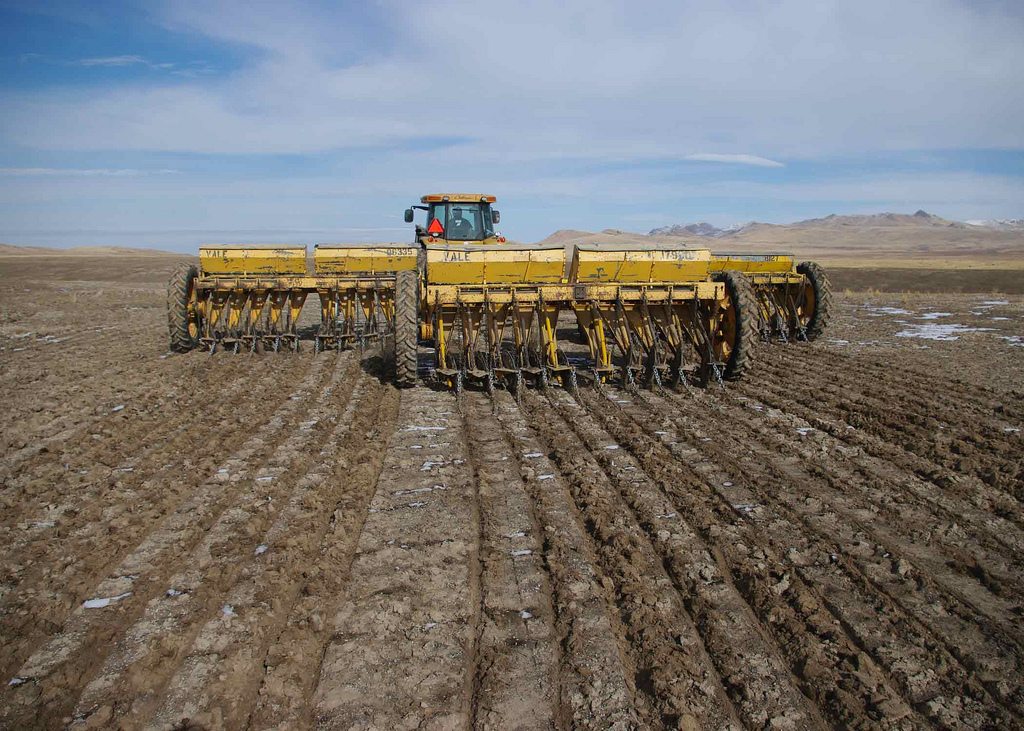
BLM NEWS RELEASE
ELKO, Nev. – The Bureau of Land Management, Elko District is wrapping up the first phase of Emergency Stabilization and Rehabilitation work across the District.
Weather conditions this winter have been ideal for BLM crews to complete nearly 100,000 acres of seeding treatments across the landscape aiding the recovery of areas burned during the 2011 wildfire season. The seeding treatments include both rangeland drills and aerial application. Nearly 500,000 pounds of seed was planted in this effort to help stabilize soils, prevent the invasion of weeds, such as cheatgrass, and to help promote the recovery of habitat for sage-grouse, mule deer, pronghorn and many other wildlife species.
Elko District worked in cooperation with many agencies to complete these treatments.
Newmont Mining Corporation contributed more than $1 million toward treatment costs in a cooperative agreement with BLM to treat private and public lands on the Chukar Canyon and Indian Creek Fire areas.
The Nevada Department of Wildlife (NDOW) provided matching funds of $250,000 in a project proposal allowing an additional $250,000 of Ruby Pipeline Mitigation funds to be used on private land rehabilitation treatments on the 2011 fires within the Elko District.
Also assisting in rehabilitation efforts was Nevada Muley’s, a non-profit group dedicated to preserving mule deer habitat in Nevada, who provided the use of a dozer in treatment efforts.
Working cooperatively with local and state agencies, approximately 17,000 acres of fire-damaged lands have been drill seeded this winter using both contract and BLM work. The majority of seeded acres used a mixture of native grass and forb species. In cheatgrass prone areas, a mixture of desirable non-natives such as Siberian wheatgrass and Russian wildrye were used to help compete with the invasive annual grass.
“In addition to the drill seeding efforts, over 80,000 acres of the 2011 fire-burned areas were aerial seeded by helicopters and fixed-winged aircraft,” said Tom Warren, Operations Manager, Elko District, BLM. “This work was completed through the use of an El Aero Services helicopter and the Elko Helitack crew, as well as Morris Ag Air.”
Nearly 100,000 pounds of sagebrush seed was aerially applied across areas of sage-grouse, mule deer and pronghorn habitat. Other aerial efforts focused on seeding drainage bottoms with a mixture of grasses and forbs in areas that experienced a high burn severity. Approximately 120,000 pounds of aerial watershed seed mix was applied across important watersheds, some of which support Lahontan cutthroat trout, a federally listed threatened species under the Endangered Species Act. These streams included Indian Jack Creek, Little Jack, Coyote and Beaver Creeks, which are tributaries to Maggie Creek and represent some of the most important interconnected populations remaining in the range of the species.
“Additional rehabilitation efforts this fiscal year will include a volunteer event on March 31,” said Warren. “This planting effort will take place on the Izzenhood Fire where sagebrush and bitterbrush seedlings will be planted by hand. This event is coordinated with the assistance of the Nevada Muley’s.”
Anyone interested in volunteering should contact Tom Warren of the BLM at (775) 753-0355. Two more seedling plantings will take place in March by BLM crews on the Salmon and Tijuana John fire areas with sagebrush and bitterbrush seedlings. About 700 acres of drill seeding on the Indian Creek Fire is planned as ground conditions allow.
As the seeding treatments wrap up, the second phase of ESR begins. This phase includes maintenance and protection of seeded areas. This maintenance includes the construction of temporary fences around portions of the burn in order to ensure recovery of native vegetation as well as protect the public land user’s investment of the seedings.
In addition, aggressive noxious weed detection surveys and treatments will be conducted across the burned areas to prevent any potential weed infestations occurring as a result of the fires. BLM weed crews will work through the summer treating weeds through an integrated approach using both chemical and mechanical methods.
Photos are available on the BLM Flickr website here: http://www.flickr.com/photos/blmnevada/collections/72157627634745149/
For raw images, please contact Lesli Ellis at (775) 753-0386.

